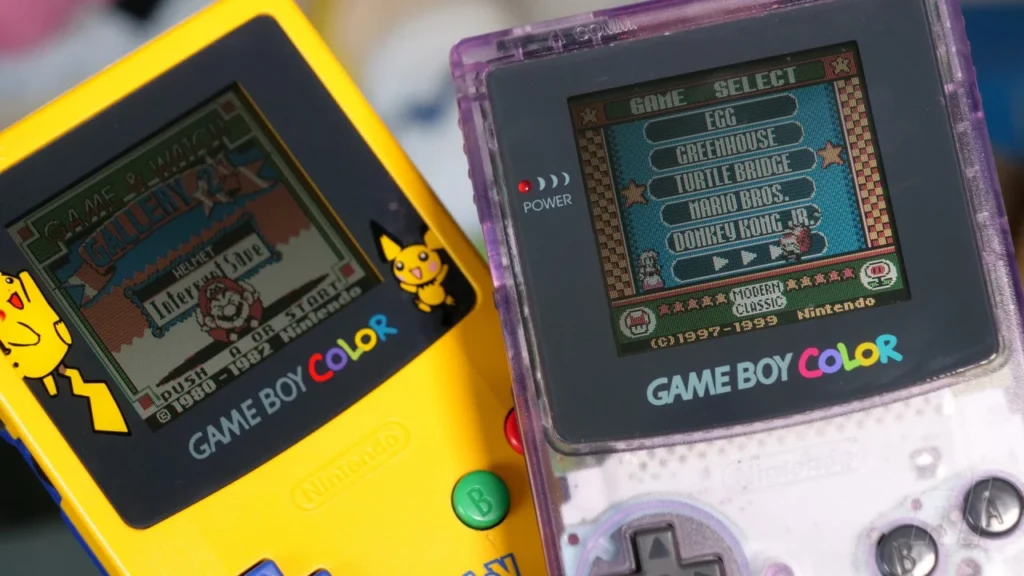In the late 1990s, the gaming industry witnessed a revolutionary leap with the introduction of the Game Boy Color. Developed by Nintendo, the Game Boy Color was the successor to the immensely popular Game Boy, and it left an indelible mark on the world of handheld gaming. Launched in 1998, this vibrant handheld console not only brought a splash of color to gaming but also expanded the possibilities for portable entertainment. In this article, we’ll delve into the history, features, and lasting impact of the Game Boy Color, exploring why it remains a cherished piece of gaming nostalgia for many.
Evolution from Monochrome to Color
The original Game Boy, released in 1989, was a monochrome handheld console that achieved tremendous success. Its library of games, simple yet addictive gameplay, and long battery life made it a favorite among gamers of all ages. However, as technology advanced, the demand for a color display became increasingly apparent.
Enter the Game Boy Color, a handheld gaming console that not only retained the core features of its predecessor but also introduced a vibrant color palette. The 2.4-inch reflective TFT color screen, with a resolution of 160×144 pixels, brought games to life in ways that the monochrome display could not. The addition of color allowed developers to create more visually engaging and immersive gaming experiences.
The Hardware
The Game Boy Color featured a custom 8-bit Sharp processor, an upgrade from the 4.19 MHz processor in the original Game Boy. This enhancement, combined with the color display, allowed for more complex and visually appealing games. The handheld console also had a Z80-like custom CPU, 32 kilobytes of RAM, and 16 kilobytes of video RAM.
One of the notable aspects of the Game Boy Color was its backward compatibility with the original Game Boy games. This meant that users could still enjoy their favorite monochrome titles on the new color console, preserving a vast library of games and ensuring a smooth transition for existing Game Boy owners.
A Vibrant Library of Games
The success of any gaming console lies in its game library, and the Game Boy Color delivered in spades. With a rich collection of over 500 games, this handheld system offered something for everyone. Iconic franchises like Pokémon, The Legend of Zelda, and Super Mario Bros. made their mark on the Game Boy Color, contributing to its widespread popularity.
The Pokémon series, in particular, played a crucial role in the success of the Game Boy Color. Titles like Pokémon Red, Blue, Gold, and Silver became bestsellers, captivating players with their immersive worlds and addictive gameplay. The ability to trade Pokémon using the Game Boy Color’s infrared communication port added a social dimension to the gaming experience.
The Legend of Zelda series also found a home on the Game Boy Color with titles like “Link’s Awakening DX” and “Oracle of Ages/Seasons.” These games showcased the console’s capabilities by delivering engaging storylines, challenging puzzles, and captivating graphics, proving that portable gaming could rival its home console counterparts.
Super Mario Bros. made a triumphant return with “Super Mario Bros. Deluxe,” offering a portable version of the classic game with added features. The Game Boy Color’s library was a diverse mix of genres, including action, adventure, puzzle, and role-playing games, ensuring that there was something for every gamer’s taste.
Connectivity and Expandability
The Game Boy Color introduced a range of connectivity options, allowing players to link up with friends and share the gaming experience. The Link Cable, an essential accessory, enabled multiplayer gaming for titles like Pokémon and Mario Kart. This social aspect of gaming added a new layer of enjoyment, as friends could trade Pokémon, engage in battles, or compete in virtual races.
Additionally, the Game Boy Color featured an infrared communication port, allowing for wireless data transfer between devices. Although not widely utilized, this feature paved the way for future advancements in handheld gaming connectivity.
The Game Boy Color also supported the use of cartridges with built-in rumble features, enhancing the gaming experience by providing tactile feedback. This innovation showcased Nintendo’s commitment to pushing the boundaries of portable gaming technology.
Legacy and Cultural Impact
The Game Boy Color’s impact extended beyond the realm of gaming. It became a cultural phenomenon, influencing popular culture and leaving an enduring mark on the childhoods of millions. Its compact design, durable build, and the ability to provide hours of entertainment on a pair of AA batteries made it the go-to companion for long car rides, family vacations, and lazy afternoons.
The console’s success also solidified Nintendo’s dominance in the handheld gaming market. Competing against other handheld systems like the Neo Geo Pocket Color and the Wonderswan, the Game Boy Colo’r emerged as the preferred choice for gamers worldwide, showcasing Nintendo’s ability to understand and cater to the desires of its audience.
The Game Boy Color’s legacy lives on in the hearts of gamers who fondly recall the countless hours spent exploring Pokémon regions, solving Zelda puzzles, and navigating Mario’s adventures. Its influence can be seen in subsequent handheld consoles, including Nintendo’s own Game Boy Advance and the Nintendo DS, both of which built upon the foundation laid by the Game Boy Color.
Conclusion
The Game Boy Colo’r holds a special place in the history of handheld gaming. Its introduction of color to the portable gaming experience, extensive game library, connectivity features, and lasting cultural impact make it a standout console of its era. While technological advancements have given rise to more sophisticated handheld devices, the Game Boy Color remains a symbol of nostalgia for those who grew up with this iconic piece of gaming history. Whether you’re a seasoned gamer who remembers the thrill of catching your first Pokémon or a newcomer curious about the roots of portable gaming, the Game Boy Colo’r stands as a testament to the enduring charm of handheld consoles.







